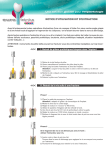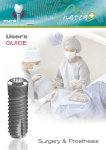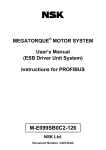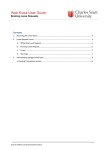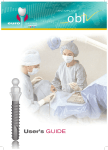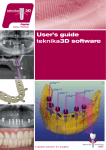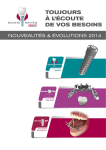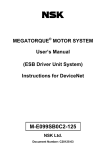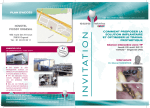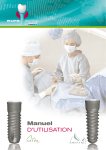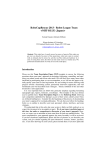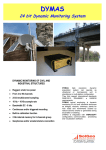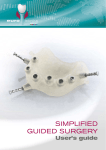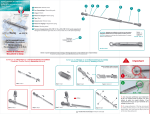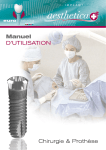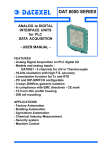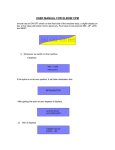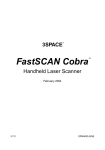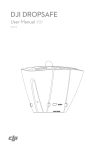Download User`s guide All In Bar 2015
Transcript
ALL BAR IN User’s GUIDE Surgery & Prosthesis ® Introduction euroteknika is the result of 22 years of clinical applications and 26 years of research and development confirmed by valuable help of international research laboratories. The design of our implants is based on the skills of our teams wich are both reactive and experienced in implantology: Technical and biomechanical skills of our engineers enabling to guarantee the resistance of the component and their adaptation to the oral environment thanks to modern means of simulation. Biological and physiological skills of the associated laboratories enabling to validate the capacity of osseointegration of our systems. Clinical and practical skills of our dentists advisers ensuring the ergonomics of our products, the confirmation of our protocols and the ranges adapted to the various clinical cases. To enable you to take the best advantage of the bar abutments, we created this manual with a profesionnal care. We invite you to read it with your best attention. Each detail, even the least important, has its importance and underlines even more the difference between the beginner and the specialist. 2 CONTENTS Warning p. 3 General information p. 5 Bar abutments p. 6 Storage kit p. 7 Protocol p. 8 to 16 IMPRESSION TAKING MATERIAL REQUIRED USE Indirect method Direct method P. P. P. P. P. 8 8 9 9 14 For more information on the ALLINBAR® system, please visit our complete internet website, www.euroteknika-implants.com 3 Warning The placement ot bar abutments must be done by a practioner who has been previously trained for the dental implantology techniques and in aseptic conditions specific to this type of treatment. The following instructions will guide you throughout the different stages of your implantology treatments. They contain advice as precise as possible but cannot be used as «recipes», every clinical situation must be evaluated for each patient. A great number of factors acts independently to obtain success in an implantology treatment. It is up to the practioner to recognize the key factors and to use his clinical experience. Among other aspects, the coordination between the prosthesis laboratory dental technician and the practioner must be perfect so as to give the global treatment plan more consisting. Only the practioner remains responsible for his different choices and decisions as to the treatment’s feasibility, implants, prosthetic parts, materials used and settings... The technical specifications and clinical advice in this manual are given solely as a guideline and cannot give rise to any claims. All the essential information is indicated in the instruction for use supplied with products. We have taken great care in the design and production of our products. However, we reserve the right to bring modifications or improvements arising from new technical developments in our implantology system.We will advise of any modifications having an implication in the operation mode. According to the importance of the modifications, a new manual will be issued. Indeed, a mark on the back page indicates the date of issue of your surgery manual, and enables us to check if you have the latest up date version. You will also be able to access our web site to check the latest version of this manual. The reproduction and distribution of all or part of this manual need previous agreement from euroteknika. 4 GENERAL INFORMATION Instructions Contraindications Multiple or total restoration Creating a rigid structure similar to a bar Limited execution time in the laboratory Immediate loading Single restoration Low primary stability (when used directly) Parts PACKAGING Sterility and rule of asepsis Most of our parts are delivered sterile and can therefore be used straightaway. A reference indicator shows the components effective sterility on the packaging. The sterility is guaranteed for 5 years (from packaging date). A standard expiry date is indicated on the label. Only an undamaged packaging can guarantee the products imperviousness and sterility. Do not use implants with packaging which has been damaged or prematurely opened. Labels Our abutments are delivered with 2 principal labels and one removable label clearly showing the mark, the reference and the batch number (for a total of 3 labels): Our products have been designed so as to enable handling without affecting their sterility. It is therefore important to follow a precise handling technique so as not to compromise the conventionnal hygiene conditions associated with the implant practice. The non sterile instruments and items delivered used for the implantology treatment must be decontaminated and, according to a tested process, sterilized at the practice. The plastic pieces (except for the occlusion abutments) cannot be sterilised by autoclave. Choose cold sterilisation. Manufacturing ! Be careful see delailed description Date of manufacturing Pilier-bar ARS_PT_AC 2 labels for the patient’s file of the practioner who placed the implant and/or of the correspondent. 1 label for the patient. Store in a dark place Store in a dry place Compling with European requirements directives regarding medical plan 93/42 CEE Use until Don’t use if the packing is damaged See the instruction manual Sanitation method using radiation Product reference number Serial number Don’t reuse Don’t sterilize twice Storage OF THE PRODUCTS The abutments must be stored in a clean, dry and cool place. Precautionary MEASURES It is strongly advised to keep in stock abutments which cover different possible cases. We recommend to use a safety thread on the instruments to avoid any accidental fall of tools in the patient’s throat. 5 BAR ABUTMENTS Description AND INFORMATION Bar abutments are designed to build a passive bar without using traditional methods. The flexibility of these abutments, and the fact that they are glued together by adding resin make it easy to build a framework. This prosthetic construction may be performed in the mouth (direct method), or in the laboratory, after taking an impression (indirect method). This is why the bar abutment has the following characteristics: Abutment with flexible winglets available in two versions (shifted and centered), and in two lengths Sandblasted abutment that enables the resin to stick Winglet bodies are flexible on the horizontal axis, making them more malleable Abutment can be used on Tetra abutments (straight or angular), available in the following ranges: Naturactis, Natea+, Naturall+, and Uneva(+) 2 horizontally flexible wings and vertically very rigid. The horizontal flexibility allows them to be easily bent in order to fit the patient’s arch anatomy. Possibility to touch up the wings by cutting them in the height and/or width Asperities (holes and irregularities) allowing the resin to infiltrate in the wings Sandblasted abutment in order to allow the resin to have a good grip Goes onto the TETRA abutments of our ranges of implants CENTERED WINGS ABUTMENT With a slight shift for the wings’ overlapping between abutments SHIFTED WINGS ABUTMENT For cases when the implant is perfectly in the teeth axis For cases when the implant is not centered in the teeth axis 6 Axis difference STORAGE KIT All the tools for building a fixed resin/titanium ALLINBAR® bridge fit into this small case. You can use the case for all your appointments with your prosthetist. SUPERIOR PLATE 8 short pick-up impression coping 8 occlusion abutments Ref. : ARSK_74 LOWER PLATE 8 Tetra abutment caps 8 short centered bar-abutments 4 short shifted bar-abutments 2 long centered bar-abutments ! 134°c BE CAREFUL 2 long shifted bar-abutments 16 bar-abutment screws DO NOT STERILIZE BY AUTOCLAVE Centered bar-abutment Supplied with fixing screw UPV_VMD.14.38 Shifted bar-abutment Supplied with fixing screw UPV_VMD.14.38 1 housing by component to make easier the component re-supplying Short Pick-up impression coping Set of 4 parts Supplied with fixing screws UPV_VGM.14.100 Occlusion abutment For occlusion registration on Tetra abutments using the indirect method. Ref. : ARS_TT.74_4 Ref. : - short : ARS_PT.AC - long : ARS_PT.AC.30 Ref. : - short : ARS_PT.AT - long : ARS_PT.AT.30 TETRA abutment cap Ref. : UPV_CPT48.20 Sold unit Ref. : UPV_PO.48 Set of 10 parts Ref. : UPV_PO.48.10 7 THE PROTOCOL Possible IMPRESSIONS An impression will only be taken if the construction is performed indirectly, in the laboratory. This is a traditional impression process on Tetra abutments. However, specific transfers are used. SHORT PICK-UP IMPRESSION (for impressions through a splint) By using short pick-up transfers, an impression with a verification of the occlusion can be made Short pick-up impression Tetra abutment Supplied with a fixing screw analog UPV_VMD.14.100 Ref. : ARS_TT.74 Ref. : UPV HM 48 STANDARD IMPRESSION (traditional method) Pick-up impression coping Ref. : UPV TM 48 or Pop-in impression coping Tetra abutment analog Ref. : UPV PI 48 Ref. : UPV HM 48 Material required FOR USING BAR ABUTMENTS FOR SETTING TETRA ABUTMENTS Internal hexagonal key External hexagonal key Ref. : CCL_HI20.24 Ref. : CCL_HE12.XX Internal hexagonal mandrel External hexagonal mandrel Ref. : UMA_HI20.26 Ref. : CMA_HE12.XX FOR USING BAR ABUTMENTS External hexagonal key Torque wrench for prosthesis Ref. : CCL_HE12.XX Ref. : CCC_35 8 Torque wrench for prosthesis Ref. : CCC_35 USE This protocol details the utilization steps, after the implants are set, and after the Tetra abutments are installed. The Tetra abutments match the solutions that the company Euroteknika offers for trans-screwed prostheses. They are available in various gum heights, and in three angulations: straight (1, 2, 3, 4 mm high), 17° (2, 3, 4 mm high), and 30° (3, 4 mm high). There are two methods: Indirect method: the bar is fitted and put together in the laboratory after a specific impression on the Tetra abutments is taken. It is recommended for implants that have already become integrated into the bone. Direct method: the bar is made and put together while the patient is in the dental chair. This technique is recommended for implants that are to be installed immediately. Indirect METHOD The bar is adjusted and put together in the laboratory after a specific impression on Tetra abutments. This technique is recommended for immediate placement. Pros Quick and simple. Adjustment of the abutment/bar by the prosthesis specialist. Step 1 Before the extraction and implant insertion, create a bite mould of the remaining teeth or on a temporary bridge (the patient’s occlusion must be stabilised). 9 Step 2 After installing the implants and the Tetra abutments, connect the pick-up transfers to the Tetra abutments. Take the impression (implant site and opposing teeth). Step 2 Tetra occlusion abutments have been developed in order to recover the occlusion registration. They are made from sterilisable plastic by autoclaving and can be retouched. In order to be able to re-position them on the master model, a flat plane has been created at the crown level. The occlusion abutments are clipped onto the straight or angulated Tetra abutments. 10 In the mouth and in occlusion, wax, resin, or silicone is applied liberally between the occlusion abutments and the opposing teeth (occlusion bite mould). This makes it possible to record the exact position of the Tetra abutments in relation to the opposing teeth. Once you have the mould, create a master model and the opposing plaster cast. The occlusion abutments are then mounted onto the analogues. Mount the master model and the opposing plaster cast onto the articulator. Then align according to the occlusion abutments and the abutment bite mould. 11 Step 4 Mount and shape the ALLINBAR® abutments. Step 5 Create the resin bridge with commercial teeth. 12 Step 6 After reception of the prosthetic set, remove the protection caps. Then screw the set onto the implants. Phase 1: screw in staggered rows on 3 points, to align the occlusion and the gum. Phase 2: manually screw the remaining screws in staggered rows. Pressure must not be applied when fitting the prosthesis to the implant connections. There must be a clear increase in torque, and it must be effortless. Note: experiencing effort on the screws, or difficulty inserting the set is a sign of inadequate passiveness. This can quickly result in an implant failure. Working on the prosthesis will thus be essential for permanent loading. Phase 3: definitively screw with the torque wrench and the external hex key, or with the external hex mandrel. Torque: 20 N.cm. Step 7 Use your method to block the screw wells (cotton or a point of gutta-percha must be used). Then make the final occlusal and aesthetic adjustments. 13 Direct METHOD The bar is made and put together in the dental chair. This technique is recommended for implants that are already osseointegrated (but it can also be used for immediate loading). Pros Framework/beam is completely passive. Cons «Tedious» work in the dental chair. Makes the «surgery» last even longer. Making occlusal splints (optional for both methods) With this technique, the occlusal splints can find the exact location of the future Tetra abutments with respect to the antagonist teeth, after extraction/implantation. The impression is taken in the occlusal splint, on the bridge side. Building these splints requires preliminary work. Step 1 (optional) Take a bite registration and an impression of the patient’s upper/lower jaws. Pour the plaster models and mount with an articulator. Create occlusion splints on the plaster models (site to be restored and opposing dental arch). Fix the female part of the occlusion pins to the opposing splint and the occlusion pins onto the splint of the arch to be restored. Step 2 (optional) Put the male ends of the occlusal pins in the female ends. Put the models in the articulator in occlusion. Connect the male ends to the splint on the side of the future bridge. A positioning bar may be added in the front. 14 Step 3 (optional) Checking the assembly. Hollow out the occlusal splint on the side of the future bridge so that the impression can be made via short pick-ups in the splint (be careful not to weaken the splint). By repositioning the impression in this splint via the 4 occlusion pins on the antagonist occlusion splint, the Tetra abutments will be perfectly repositioned with respect to the antagonist teeth. Create the titanium framework in the mouth and bridge in the laboratory. Step 1 (For the creation of a bridge with immediate loading) Screw the Tetra abutments on the implants (see the procedure in the surgery manual or the Tetra product sheet). Then screw the protection caps onto the Tetra abutments. Stitch around these caps. Step 2 Unscrew the caps and adjust the bar abutments one at a time, keeping their lengths in mind. They should be long enough to overlap with each other, and should limit misalignment in the back. Use a cutting disc for this. 15 Step 3 Fold the winglets, following the curve of the dental arch, with gouge forceps. The winglets must be folded outside of the patient’s mouth. Applying too much stress on implants that are not osseointegrated may result in primary failure. Step 4 Manually screw the abutments with a torque wrench and external hex key, or use the hex mandrel. Torque: 20 N.cm. Step 5 Attach the abutments to each other with the white resin for dentures that prosthetists use. This resin will be mixed in a syringe, and applied to the holes. Be careful not to fill the screw wells. A dam must be used. 16 Step 6 Install the occlusion splint around the framework that has already been built. Attach the occlusal splint to the framework with dots of wax in the vestibule. Then register the occlusion of the antagonist teeth with respect to the ALLINBAR® framework. After the occlusion is registered, remove the antagonist occlusal splint. Step 7 Use high-resolution impression silicon to take the impression of the peri-implant gum. Then bind the framework to the splint with traditional impression material. Keep access to the screw wells free. Step 8 Unscrew the splint/framework ensemble, mount the analogues on the bar abutments and send to the laboratory. Fix the protective caps onto the Tetra abutments. 17 Step 9 Create the master model. Mount the master model on the articulator and align using the opposing plaster cast, using the occlusion splints. (This re-alignment could also potentially be done with the technique using occlusion abutments). Step 10 Build dentures with resin in the laboratory. 18 Step 11 After reception of the prosthetic set, remove the protection caps. Then screw the set onto the implants. Phase 1: screw in staggered rows on 3 points, to align the occlusion and the gum. Phase 2: manually screw the remaining screws in staggered rows. Pressure must not be applied when fitting the prosthesis to the implant connections. There must be a clear increase in torque, and it must be effortless. Note: experiencing effort on the screws, or difficulty inserting the set is a sign of inadequate passiveness. This can quickly result in an implant failure. Working on the prosthesis will thus be essential for permanent loading. Phase 3: definitively screw with the torque wrench and the external hex key, or with the external hex mandrel. Torque: 20 N.cm. Step 12 Use your method to block the screw wells (cotton or a point of gutta-percha must be used). Then make the final occlusal and aesthetic adjustments. 19 A global solution FOR IMPLANTOLOGY euroteknika groupe 726 rue du Général De Gaulle - 74700 SALLANCHES - France Tél. : 33 (0)4 50 91 49 20 - Fax : 33 (0)4 50 91 98 66 www.euroteknika.com MU_ALLINBAR.GB_1402




















